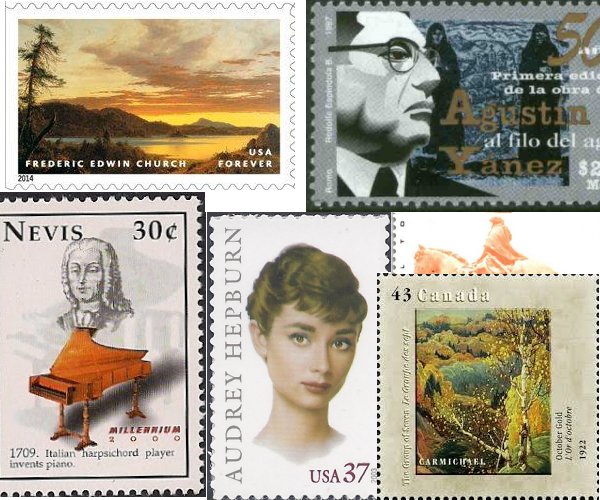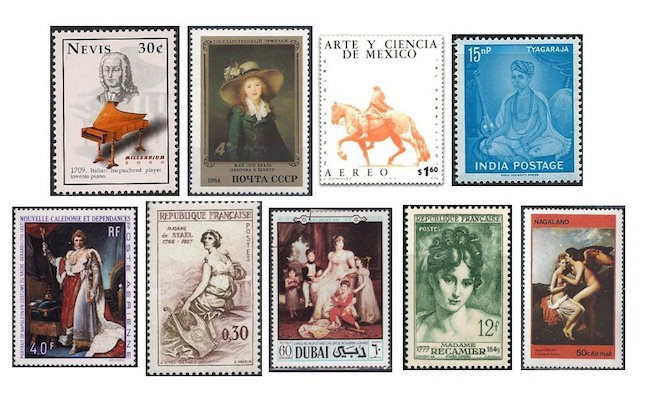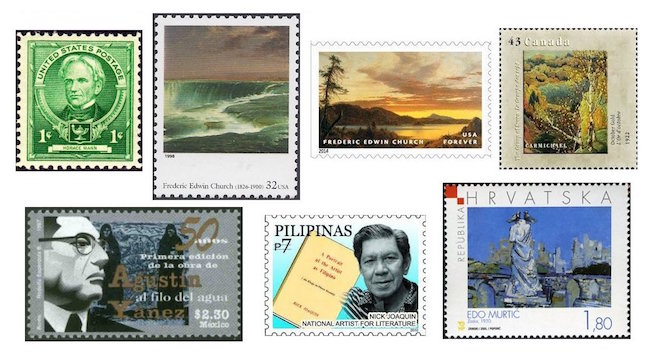The Arts on the Stamps of the World — May 4
An Arts Fuse regular feature: the arts on stamps of the world.

By Doug Briscoe
Audrey Hepburn and American landscape painter Frederic Church are our most famous names for this May 4, but besides them we celebrate three more painters: Jean Louis Voille, Franklin Carmichael, and Edo Murtić; architect Manuel Tolsá; writers Agustín Yáñez and Nick Joaquín, and more.
May 4 is the birthday of Bartolomeo Cristofori, the inventor of the piano. He was born in Padua in 1655, but next to nothing is known of his youth. From the age of 33 he worked for a prince of the Medicis overseeing a collection of musical instruments. Before inventing the piano, Cristofori developed two variants of the spinet, a spinettone or “large spinet” and an oval spinet with the longest strings in the middle. The spinettone may have been designed with the intention of projecting a bigger sound when combined with an orchestra, and this object may have sparked the idea for the first piano. One of these must have been made no later than 1700, as it shows up in an inventory from that year as a “nuova inventione, che fa’ il piano, e il forte,” that is, a “new invention that produces soft and loud.” The name “pianoforte” became shortened over time to “piano.” The stamp from the island of Nevis (erroneously giving 1709 as the year of invention) comes from a large set celebrating the millenium by depicting important developments of the past thousand years. The portrait derives from a now lost painting of 1726 (it was destroyed in World War II, and only photographs remain). We don’t know how many pianos Cristofori built, but only three remain extant besides a number of harpsichords, a spinettone, and two oval spinets. The pianos are housed in museums in New York (the Metropolitan Museum), Rome, and Leipzig. Bartolomeo Cristofori died on January 27 (which we now celebrate as Mozart’s birthday) in 1731.
French portraitist Jean-Louis Voille (4 May 1744 – 20 Novembre 1829) did most of his work in Russia between 1768 and 1804, with a return to France in the years 1782-5. Just prior to his departure he was court painter to Prince Pavel Petrovich, who became Tsar Paul I in 1796. Voille painted his portrait in 1799. On leaving Russia in 1804 it seems Voille gave up painting. His portrait of the Baroness Stroganova (see the stamp) was for a time attributed to Elisabeth Vigée-Lebrun.

Spanish architect and sculptor Manuel Tolsá (May 4, 1757 – December 24, 1816) was active in both Spain and Mexico, where he ended his days. Named sculptor of the king’s chamber (he was also Minister of the Supreme Junta of Commerce, Minting and Mines, I’ll have you know), he went to the New World in 1791 at the behest of King Charles IV, having already been appointed first director of the new Academy of San Carlos in Mexico City. His experience in engineering made him an ideal choice for supervisor of the city’s drainage and water supply systems, and his knowledge of mining no doubt contributed to his first important architectural assignment, the Palacio de Minería, the home of the Royal School of Mines and Mining. At the same time Tolsá was working on his equestrian statue of Charles IV (1796-1803), seen on the stamp. No less a figure than Alexander von Humboldt praised this work: “with the exception of the Marcus Aurelius at Rome, [it] surpasses in beauty and purity of style everything which remains in this way in Europe.” The brilliant Tolsá also cast cannons and applied his talents to the design of altars, furniture, and coaches.
Known as Saint Tyāgarāja (or Tyāgayya in Telugu), Kakarla Tyagabrahmam (4 May 1767 – 6 January 1847) is seen as one of the greatest composers of Carnatic music. Enormously prolific, he wrote thousands of classical pieces, mainly devotional works composed in praise of the god Rama, though much of this work has been lost. All the same, some 700 pieces remain. Tyāgarāja also composed two musical plays in Telugu. There is an annual week-long music festival at Thiruvaiyaru in Tamil Nadu in his honor.
François Pascal Simon, Baron Gérard (4 May 1770 – 11 January 1837) studied with Jacques-Louis David. A prolific painter, he produced many portraits, several of them very well known. First among these, I suppose, would be the portrait of Napoleon as emperor as seen on the stamp from New Caledonia; next the well-known portrait of Madame de Staël; then the one of Caroline Murat and her children (1808-10) and a detail from one of Madame Récamier (1805). Finally we have one of Gérard’s genre paintings, Cupid and Psyche of 1798. It was rather in historical painting that Gérard wanted to make his mark, and in later life he suffered disillusionment despite his many accolades and honors.

Worth a mention here, I think, is Horace Mann (May 4, 1796 – August 2, 1859) for his efforts promoting public education. As a consequence a great many schools in the United States are named for him. He was a legislator in Massachusetts and in the U.S. House of Representatives. His statue by Emma Stebbins (1865) stands outside the State House in Boston.
One of America’s finest landscape artists was surely Frederic Edwin Church (May 4, 1826 – April 7, 1900). We tend to think of him as quintessentially American, an emblematic representative of the Hudson River School, but in his wide travels he also painted Central and South America, the Mediterranean, the Middle East, even the Arctic. Descended from the Puritans, Church was a pupil of Thomas Cole and at 23 became the youngest Associate of the National Academy of Design. After 1876 rheumatoid arthritis forced him to transfer the brush to his left hand. Two U.S. stamps portray his work: Niagara Falls (1857) on a 1998 issue and Sunset (1856) on one from 2014.
Another North American painter was the Canadian Franklin Carmichael (May 4, 1890 – October 24, 1945). He was youngest of the original members of the Group of Seven and the first of them we’ve had a chance to explore in this series. (Disclaimer: Frederick Varley was born in January, but I missed it.) After studies at the Ontario College of Art and an apprenticeship at the design firm Grip Ltd, Carmichael went to Belgium for further instruction but returned home on the outbreak of World War I. Though members of the Group of Seven had associated at Grip for years, it was only in 1919 that they began to refer to themselves by that collective name. Carmichael is represented on a 1995 Canadian stamp with his October Gold of 1922. It comes from one of three stamp sheets devoted to works by the Group of Seven (including later members).

Let’s make a clean sweep of North America with an artist from Mexico, novelist Agustín Yáñez (May 4, 1904 – January 17, 1980). In addition to his political positions as Governor of Jalisco and Secretary of Public Education, he authored a dozen novels, of which Al filo del agua (On the Edge of the Storm, 1947) is seen as his masterpiece. Here can be felt the influence of such giants as Faulkner, Kafka, and Joyce. Referring to Al filo del agua and Pedro Páramo (1955) by Juan Rulfo (whose birthday approaches), Carlos Fuentes wrote: “After these two Great novels, real masterpieces, it was no longer possible to add anything, everything was said.”
Another bright light among the literati was Nick (Nicomedes) Joaquín (May 4, 1917 – April 29, 2004) of the Philippines. His father had been a high-ranking officer in the 1896 Revolution and a successful lawyer thereafter. Having immersed himself in his father’s library, Joaquín took to writing early and made a name for himself with his poems, stories and plays. He also worked as an historian, with particular regard for the great Filipino patriot and polymath José Rizal, and as a novelist. He wrote mostly in English, sometimes using the pseudonym Quijano de Manila.
Edo Murtić (1921–2005) was a Croatian artist who worked with a wide variety of media: mainly oils and gouache, but also ceramics, etc., and who produced mosaics and murals as well as posters, illustrations, and set design. He fought against the fascists with his art as well as in the field and went to America and Canada in 1951, encountering abstract expressionism there. The still quite representational painting Zadar, seen on the stamp, dates from 1953.
Our last (youngest) subject today is the enchanting Audrey Hepburn (born Audrey Kathleen Ruston; 4 May 1929 – 20 January 1993), and she happens to come with a fascinating—well, interesting—stamp story. First I’ll draw your attention to the stamps from the United States, Canada (the latter from a set of three honoring photographer Yousuf Karsh), and Gibraltar (bottom left) and the minisheet from Guinea, then we come to the German issue, which, it turns out, you can’t get unless you’re prepared to pay tens or even hundreds of thousands of dollars for it. Somehow Deutsche Post neglected to get permission to use the image, and Hepburn’s son Sean Ferrer, an anti-tobacco activist, refused to let them use it. 14 million copies were ordered destroyed, but a few of them, at least, went through the postal system, and five have been found since the year of issue, 2001. (The first only turned up in 2004!) The highest amount paid for one of these five was €135,000. (Sean Ferrer himself kept a sheet of ten mint stamps, which he auctioned off for charity in 2010 for €430,000.) So if you happen to have any old mail from Germany lying around…
A graduate of the University of Massachusetts with a B.A. in English, Doug Briscoe worked in Boston classical music radio, at WCRB, WGBH, and WBUR, for about 25 years, beginning in 1977. He has the curious distinction of having succeeded Robert J. Lurtsema twice, first as host of WGBH’s weekday morning classical music program in 1993, then as host of the weekend program when Robert J.’s health failed in 2000. Doug also wrote liner notes for several of the late Gunther Schuller’s GM Recordings releases as well as program notes for the Boston Classical Orchestra. For the past few years he’s been posting a Facebook “blog” of classical music on stamps of the world, which has now been expanded to encompass all the arts for The Arts Fuse.
